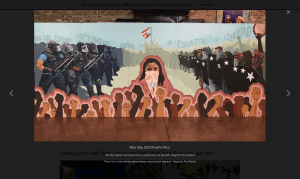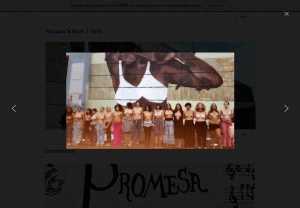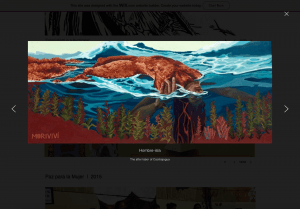Colectivo Morivivi make artwork that puts the voice and artistic expression of the people as the focal point. Representation matters and the women behind Morivivi choose to represent a vulnerable community within Puerto Rico: women of color. Their focus on central issues that affect Puerto Rico such as environmental disasters, U.S imperialism and reproductive rights are feminist issues as well and their involvement with the diaspora highlights their collaborative efforts of solidarity and unity. The work of Colectivo Morivivi, especially the piece “May Day 2018” relates heavily to the issues of decolonization. The quote used in the mural “no hay estado intermedio entre la esclavitud y la libertad,” by Segundo Ruiz Belvis provides viewers with the context of liberation struggles and tells us that these movements for sovereignty have not ended, but has only increased with U.S imperialism and intervention.
Image screengrabbed from https://www.colectivomorivivi.com/community-projects
The protest at May Day proves what we have reading about Puerto Rico during the semester- how U.S intervention has imposed an economic and political crises onto the people of Puerto Rico. In “Beyond Nationalist and Colonialist Discourses: The Jaiba Politics of the Puerto Rican-Ethno Nation,” the writers delve into the dichotomous concept of colonialism/nationalism. While mural uses the quote of Ruiz Belvis stating that there is no halfway point between slavery and liberty, the writers explain how full on liberation could be debilitating for the nation. However, Puerto Rico must be free in terms of their own political representation, because they have no senators and its representative in the House of Representatives is a delegate called the Resident Commissioner, with limited voting rights and privileges. “The U.S Congress has absolute authority over Puerto Rico’s local political structures,” the reading states and that, “any measure taken by the Puerto Rican legislature can be unilaterally invalidated by the U.S Congress.” Puerto Rico is indeed a colonial possession under congressional jurisdiction and the reading accurately points out that Puerto Rico has a double coloniality of power, one of U.S Congress determining all aspects of Puerto Rico and the other of power by local elites who uphold racist structures.
In the mural, the two colonial powers are being challenged. Those who are front and center protesting and in unity are not creole elites who exercise power under the banner of nationalism, but those who truly are fighters for justice. Additionally, the fact that the mural is about May Day in 2018, where people protested over budget cuts and austerity measures, challenges the U.S’s economic hold over Puerto Rico, and how many will not stand for it. Retaliation against police forces also demonstrates a form of resistance. Thus, the mural’s political and social commentary is one that does not simply question imperialism, but demands decolonization of Puerto Rico’s political and economic sectors.
Images screengrabbed from https://www.colectivomorivivi.com/community-projects
As we mentioned earlier, the work of Colectivo Morivivi clearly reflects much decolonial thought, as their pieces of artwork often question dominant power structures, and symbolize the lived experiences of those at the hands of these structures. The third mural that we chose to discuss was called, “Paz para la Mujer,” or “Peace for the Woman.” This mural was created with an organization titled, “Paz para la Mujer,” (http://www.pazparalamujer.org) in collaboration for International Day for the Elimination of Violence against Women (https://www.un.org/en/events/endviolenceday/). This artwork ties to María Lugones,’ “Playfulness, ‘World’-Travelling, and Loving Perception,” because it aims to humanize and soften the perception that the dominant culture in Puerto Rico assigns to Black women and their bodies; in a way, ‘traveling to their world.’ According to an interview done with Teen Vogue, member Chachi González, shared that the butterflies, or mariposas, are meant to represent three Dominican sisters who were murdered by dictator Rafael Trujillo in 1960, which caused the creation of the International Day for the Elimination of Violence against Women. As one can see in the image above, the mural was defaced, not even one year after the painting of it. Though this was a clear disappointment, women local to the area were not intimidated; they were incited to set up counter-protests of their own, taking images topless and breastfeeding their babies in front of the mural. These reactions to the vandalism of the artwork further prove the decolonial nature of the art; it can inspire people to come together and advocate for the message of the piece.
Image screengrabbed from https://www.colectivomorivivi.com/community-projects
The murals created by Colectivo Morivivi are a clear example of how art made to represent Puerto Ricans, made by Puerto Ricans takes on a more genuine meaning as opposed to that which is produced by foreign bodies. The authenticity of the messages that are intended to be conveyed are done with far more care and attention paid to the details that make up the day to day struggles faced by members of the Puerto Rican community found both within the territory itself, and those living in the diaspora. The murals this group has created emphasize the importance of a collective story and the power that can be found within the bonds formed by firm supporters of a common movement. An individual that is not a member of the community, one that has no true intentions of getting to know the individuals they are portraying in their “art”, which does not give the participants a genuine voice. One of the points raised by Llorens was that there was too much of an artificial presence in the photo that was taken of the Puerto Rican Natives. The staged photo offered no true insight of what daily life was like for the people living there, and it did not seem like there was much interest in that fact to begin with being that there was no way of knowing who the individuals were and whether or not they had any relational ties to one another. The goal of the murals created by Colectivo Morivivi is to inspire and cultivate the movement toward giving people impacted by hardship a voice of their own and a beautiful outlet to express it. The mural “Hombre-Isla” was meant to signify the movement of a community to rebuild itself with the help its inhabitants and create something upon which their lives could thrive and they would be able to flourish together.
https://docs.google.com/presentation/d/1kyfb0oJICZDGKIG0nQsb67UldaLXCGGrbUugxPDglJ4/edit?usp=sharing
Links to sources used:
https://www.colectivomorivivi.com/community-projects
https://www.womenarts.org/2018/04/10/puerto-rican-art-collective-creates-murals-and-social-change/
http://remezcla.com/features/culture/moriviv-mural-vandalized-puerto-rico/
www.colectivomorivivi.com/our-work/
www.pazparalamujer.org/index.php/2016-05-15-0
www.teenvogue.com/story/art-collective-colectivo-morivivi-puerto-rico




